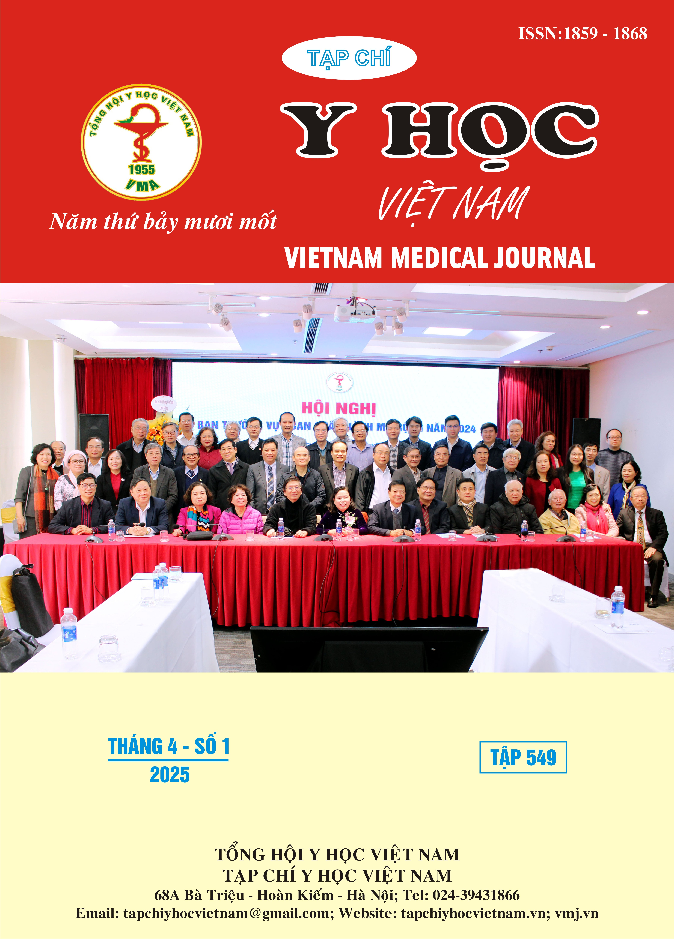HOSPITALIZATION RATE IN THE FIRST 6 MONTHS OF ANTIRETROVIRAL TREATMENT AMONG NEWLY DIAGNOSED HIV-INFECTED PATIENTS AT THE HOSPITAL FOR TROPICAL DISEASES, 2023-2024
Main Article Content
Abstract
Backround: HIV/AIDS treatment in Vietnam has undergone significant advancements, including the introduction of early antiretroviral therapy (ARV) initiation since 2017 and the adoption of Dolutegravir (DTG) in first-line regimens since 2019. Despite these improvements, newly treated ARV patients still account for a high proportion of hospitalizations among people living with HIV/AIDS. Objective: To determine the hospitalization rate and describe related factors within the first six months of ARV treatment in newly diagnosed HIV/AIDS patients. Methods: A descriptive, prospective cross-sectional study was conducted at the outpatient clinic of the Hospital for Tropical Diseases from October 2023 to July 2024. Participants included HIV-positive patients aged 18 years or older who were newly diagnosed and initiated ARV treatment within one month of diagnosis. Data collected included demographic characteristics, clinical and laboratory findings at ARV initiation, hospitalization frequency, and reasons for hospitalization. Results: Among 76 participants, 26% (20 patients) were hospitalized during the first six months of ARV treatment, with 88% of hospitalizations occurring within the first three months. The primary causes of hospitalization were tuberculosis (34.5%) and Pneumocystis jiroveci pneumonia (26.9%). Risk factors for hospitalization included underweight status (OR = 4.5), clinical stage 3-4 (OR = 21.9), non-adherence to ARV (OR = 4.1), anemia (OR = 6), and CD4+ T-cell count < 200 cells/mm³ (OR = 3.5). Multivariate regression analysis identified clinical stage 3-4 as an independent risk factor for hospitalization (OR = 20.31). Conclusion: The hospitalization rate during the first six months of ARV treatment remains high, particularly among patients in advanced disease stages. Tuberculosis is the most common cause of hospitalization. Recommendations: Early screening and treatment of opportunistic infections, especially tuberculosis, should be prioritized for newly treated HIV patients. Efforts to enhance early HIV detection and diagnosis should be strengthened.
Article Details
Keywords
HIV/AIDS, ARV, hospitalization, clinical stage 3-4, tuberculosis, opportunistic infections
References
2. Mahale PR, Patel BS, Kasmani N. Treatment Outcomes of Dolutegravir- Versus Efavirenz-Based Highly Active Antiretroviral Therapy Regimens Among Treatment-Naive People Living With HIV. Cureus. Jun 2023;15(6):e40139. doi:10.7759/ cureus.40139
3. Nguyễn Thị Hoài Dung, Nguyễn Thị Dung, Phạm Thanh Tuyến. Đánh giá hiệu quả của phác đồ Acriptega trong năm đầu tiên trên người nhiễm HIV chưa từng điều trị ARV. Truyền nhiễm Việt Nam. 2023;01(41)
4. Nguyễn Kim Thư, Phạm Bá Hiền, Lê Xuân Toản. Đánh giá hiệu quả điều trị của phác đồ ARV TDF+ 3TC+ DTG trên bệnh nhân HIV/AIDS tại Bệnh viện đa khoa Đống Đa 2020-2021. Tạp chí Y học Việt Nam. 2022;511(2)
5. Trần Minh Hoàng, Lý Quốc Công, Nguyễn Lê Như Tùng, và cs. Đặc điểm dịch tễ, lâm sàng và kết cục ở bệnh nhân HIV/AIDS nhập viện tại bệnh viện Bệnh Nhiệt đới Thành phố Hồ Chí Minh. Tạp chí Y học Cộng đồng. 2024;65(CD6-HNKH Bệnh viện Lê Văn Thịnh)
6. Mendicino CC, Moodie EE, Guimarães MDC, Pádua CA. Immune recovery after antiretroviral therapy initiation: a challenge for people living with HIV in Brazil. Cadernos de Saúde Pública. 2021;37:e00143520.
7. Liu Y, Hao Y, Xiao J, et al. Trends in rates and causes of hospitalization among people living with HIV in the antiretroviral therapy era: A retrospective cohort study in China, 2008-2020. Front Public Health. 2022;10:1000942. doi:10. 3389/fpubh.2022.1000942
8. World Health Organization, ed. Global Tuberculosis report 2023. 2023.


